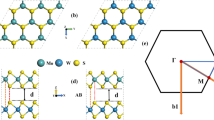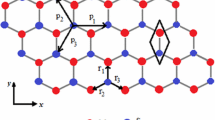Abstract
Understanding pressure-regulated electronic properties is crucial for integrating two-dimensional semiconductors into flexible electronic devices and pressure sensors. We thoroughly explored the tunability of the electronic structure of monolayer MoS2 upon the application of perpendicular pressure and shear stress by using first-principles calculations. The band gap increased at low pressures and then decreased as the pressure increased. Variations in the band gap are caused by the combined interaction of the increasing and decreasing trends in the band gap. The increase in the band gap is induced by the enhancement of the p–d orbital interaction at the top of the valence band (TVB). The delocalization of charge and unstable hybridization bonding causes a reduction in the band gap. The band gap under perpendicular pressure modes is closely related to the structural variation. Shear stress can effectively reduce the band gap with minimal change to the crystal structure. The maximum point at the TVB and the minimum point at the bottom of the conduction band are different for all pressure modes, resulting in various anisotropic properties. This study provides a theoretical basis for modulating the electrical and optical properties of monolayer MoS2.
Graphical Abstract

摘要
了解电子性质的压力可调节性对将二维半导体应用于柔性电子设备和压力传感器中至关重要。我们利用第一性原理计算, 深入探讨了垂直压力和剪应力作用下单层MoS2的电子结构的可调性。带隙的变化是由带隙增大和减小趋势的共同作用引起的。随着压力的增大, 带隙先增大后减小。其中, 价带顶端p-d轨道相互作用的增强引起了禁带宽度的增加; 电荷的离域和成键的稳定降低使能带隙减小。施加垂直压力时, 材料的带隙与结构的变化密切相关。但剪应力却晶体结构变化极小时有效地减小带隙。不同的施压模式引起能带价带顶和导带底部结构变化剧烈, 从而导致材料在不同压力模式下具有分明的各向异性特性。本研究为调制MoS2单分子层的电学和光学性质提供了理论依据。








Similar content being viewed by others
References
Radisavljevic B, Radenovic A, Brivio J, Giacometti V, Kis A. Single-layer MoS2 transistors. Nat Nanotechnol. 2011;6(3):147.
Pereira VM, Castro NA, Liang HY, Mahadevan L. Geometry, mechanics, and electronics of singular structures and wrinkles in graphene. Phys Rev Lett. 2010;105(15):156603.
Hsu WT, Lu LS, Wang D, Huang JK, Li MY, Chang TR, Chou YC, Juang ZY, Jeng HT, Li LJ, Chang WH. Evidence of indirect gap in monolayer WSe2. Nat Commun. 2017;8(1):929.
He B, Ren YX, Dai TJ, Hou S, Liu XZ. Characterization and performance of graphene–PbSe thin film heterojunction. Rare Met. 2021;40(1):219.
Hao M, Zeng W, Li YQ, Wang ZC. Three-dimensional graphene and its composite for gas sensors. Rare Met. 2021;40(6):1494.
Li Y, Lu YL, Wu KD, Zhang DZ, Debliquy M, Zhang C. Microwave-assisted hydrothermal synthesis of copper oxide-based gas-sensitive nanostructures. Rare Met. 2021;40(6):1477.
Wei ZY, Hu KM, Sa BS, Wu B. Pressure-induced structure, electronic, thermodynamic and mechanical properties of Ti2AlNb orthorhombic phase by first-principles calculations. Rare Met. 2021;40(10):2964.
Rahnamaye AH, A, Nodehi Z, Maleki B, Abareshi A. Electronical and thermoelectric properties of half-Heusler ZrNiPb under pressure in bulk and nanosheet structures for energy conversion. Rare Met. 2019;38(11):1015.
Lv Z, Tang Y, Zhu Z, Wei J, Li W, Xia H, Jiang Y, Liu Z, Luo Y, Ge X, Zhang Y, Wang R, Zhang W, Loh XJ, Chen X. Honeycomb-lantern-inspired 3D stretchable supercapacitors with enhanced specific areal capacitance. Adv Mater. 2018;30(50):1805468.
Lv Z, Li W, Yang L, Loh XJ, Chen X. Custom-made electrochemical energy storage devices. ACS Energy Lett. 2019;4(2):606.
Miwa JA, Ulstrup S, Sørensen SG, Dendzik M, Čabo AG, Bianchi M, Lauritsen JV, Hofmann P. Electronic structure of epitaxial single-layer MoS2. Phys Rev Lett. 2015;114(4):046802.
Docherty CJ, Parkinson P, Joyce HJ, Chiu MH, Chen CH, Lee MY, Li L, Herz LM, Johnston MB. Ultrafast transient terahertz conductivity of monolayer MoS2 and WSe2 grown by chemical vapor deposition. ACS Nano. 2014;8(11):11147.
Zhan Y, Liu Z, Najmaei S, Ajayan PM, Lou J. Large-area vapor-phase growth and characterization of MoS2 atomic layers on a SiO2 substrate. Small. 2012;8(7):966.
Mak KF, Lee C, Hone J, Shan J, Heinz TF. Atomically thin MoS2: a new direct-gap semiconductor. Phys Rev Lett. 2010;105(13):136805.
Banerjee S, Richardson W, Coleman J, Chatterjee A. A new three-terminal tunnel device. IEEE Electron Dev Lett. 1987;8(8):347.
Wang R, Sun Y, Yang K, Zheng J, Li Y, Qian Z, He Z, Zhong S. One-time sintering process to modify xLi2MnO3 (1–x)LiMO2 hollow architecture and studying their enhanced electrochemical performances. J Energ Chem. 2020;50:271.
Farkous M, Bikerouin M, Thuan DV, Benhouria Y, El-Yadri M, Feddi E, Erguig H, Dujardin F, Nguyen CV, Hieu NV, Bui HD, Hieu NN, Phuc HV. Strain effects on the electronic and optical properties of Van der Waals heterostructure MoS2/WS2: a first-principles study. Physica E Low Dimens Syst Nanostruct. 2020;116:113799.
Deng S, Che S, Debbarma R, Berry V. Strain in a single wrinkle on an MoS2 flake for in-plane realignment of band structure for enhanced photo-response. Nanoscale. 2019;11(2):504.
He X, Li H, Zhu Z, Dai Z, Yang Y, Yang P, Zhang Q, Li P, Schwingenschlogl U, Zhang X. Strain engineering in monolayer WS2, MoS2, and the WS2/MoS2 heterostructure. Appl Phys Lett. 2016;109(17):173105.
Trainer DJ, Zhang Y, Bobba F, Xi X, Hla SW, Iavarone M. The effects of atomic-scale strain relaxation on the electronic properties of monolayer MoS2. ACS Nano. 2019;13(7):8284.
Chen Y, Deng W, Chen X, Wu Y, Shi J, Zheng J, Chu F, Liu B, An B, You C, Jiao L, Liu X, Zhang Y. Carrier mobility tuning of MoS2 by strain engineering in CVD growth process. Nano Res. 2020;14:2314.
Carrascoso F, Li H, Frisenda R, Castellanos-Gomez A. Strain engineering in single-, bi- and tri-layer MoS2, MoSe2, WS2 and WSe2. Nano Res. 2021;14(6):1698.
Lee JH, Jang WS, Han SW, Baik HK. Efficient hydrogen evolution by mechanically strained MoS2 nanosheets. Langmuir. 2014;30(32):9866.
Meng X, Pandey T, Jeong J, Fu S, Yang J, Chen K, Singh A, He F, Xu X, Zhou J, Hsieh W-P, Singh AK, Lin JF, Wang Y. Thermal conductivity enhancement in MoS2 under extreme strain. Phys Rev Lett. 2019;122(15):155901.
Xu W, Yan S, Qiao W. Magnetism in monolayer 1T-MoS2 and 1T-MoS2H tuned by strain. RSC Adv. 2018;8(15):8435.
Lin Q, Xu N, Li G, Qian Z, Liu H, Wang R. Carrier and vacancy mediated ferrimagnetism in Cu doped rutile TiO2. J Mater Chem C. 2021;9(8):2858.
Li T, Galli G. Electronic properties of MoS2 nanoparticles. J Mater Chem C. 2007;111(44):16192.
Scalise E, Houssa M, Pourtois G, Afanas’ev V, Stesmans A. Strain-induced semiconductor to metal transition in the two-dimensional honeycomb structure of MoS2. Nano Res. 2012;5(1):43.
Fu L, Wan Y, Tang N, Ding Y, Gao J, Yu J, Guan H, Zhang K, Wang W, Zhang C, Shi J, Wu X, Shi SF, Ge W, Dai L, Shen B. K-Λ crossover transition in the conduction band of monolayer MoS2 under hydrostatic pressure. Sci Adv. 2017;3(11):e1700162.
Shahriari M, Dezfuli AG, Sabaeian M. Investigation of uniaxial and biaxial strains on the band gap modifications of monolayer MoS2 with tight-binding method. Superlattic Microst. 2019;125:34.
Guo Y, Li B, Huang Y, Du S, Sun C, Luo H, Liu B, Zhou X, Yang J, Li J, Gu C. Direct bandgap engineering with local biaxial strain in few-layer MoS2 bubbles. Nano Res. 2020;13(8):2072.
Fan X, Chang CH, Zheng WT, Kuo JL, Singh DJ. The electronic properties of single-layer and multilayer MoS2 under high pressure. J Mater Chem C. 2015;119(19):10189.
Li F, Shen T, Xu L, Hu C, Qi J. Strain Improving the performance of a flexible monolayer MoS2 photodetector. Adv Electron Mater. 2019;5(12):1900803.
Hu Y, Zhang F, Titze M, Deng B, Li H, Cheng GJ. Straining effects in MoS2 monolayer on nanostructured substrates: temperature-dependent photoluminescence and exciton dynamics. Nanoscale. 2018;10(12):5717.
Heyd J, Scuseria GE, Ernzerhof M. Hybrid functionals based on a screened Coulomb potential. J Chem Phys. 2003;118(18):8207.
Heyd J, Scuseria GE, Ernzerhof M, Erratum, Hybrid functionals based on a screened Coulomb potential. [J. Chem. Phys. 118, 8207 (2003)], J Chem Phys. 2006; 124(21): 219906.
Ding Y, Wang Y, Ni J, Shi L, Shi S, Tang W. First principles study of structural, vibrational and electronic properties of graphene-like MX2 (M=Mo, Nb, W, Ta; X=S, Se, Te) monolayers. Physica B. 2011;406(11):2254.
Qiu DY, da Jornada FH, Louie SG. Optical spectrum of MoS2: many-body effects and diversity of exciton states. Phys Rev Lett. 2013;111(21):216805.
Wang QH, Kalantar-Zadeh K, Kis A, Coleman JN, Strano MS. Electronics and optoelectronics of two-dimensional transition metal dichalcogenides. Nat Nanotechnol. 2012;7(11):699.
Dybała F, Polak MP, Kopaczek J, Scharoch P, Wu K, Tongay S, Kudrawiec R. Pressure coefficients for direct optical transitions in MoS2, MoSe2, WS2, and WSe2 crystals and semiconductor to metal transitions. Sci Rep. 2016;6(1):26663.
Zhong M, Zeng W, Tang H, Wang LX, Liu FS, Tang B, Liu QJ. Band structures, effective masses and exciton binding energies of perovskite polymorphs of CH3NH3PbI3. Sol Energy. 2019;190:617.
Lou P, Lee JY. Origin of structural stability of ScH3 molecular nanowires and their chemical-bonding behavior: correlation effects of the Sc 3d electrons. J Chem Phys. 2019;150(18):184307.
Miao MS, Hoffmann R. High pressure electrides: a predictive chemical and physical theory. Acc Chem Res. 2014;47(4):1311.
Rousseau B, Ashcroft NW. Interstitial electronic localization. Phys Rev Lett. 2008;101(4):046407.
Acknowledgements
This research was financially supported by the National Key R&D Program of China (No. 2019YFB2204500), Shenzhen Science and Technology Program (No. KQTD20180412181422399), the Science and Technology Innovation Commission of Shenzhen (Nos. JCYJ20180507181858539 and JCYJ20190808173815205), the National Natural Science Foundation of China (Nos. 11575074, 11975006 and 51804199) and the Natural Science Foundation of Guangdong Province (No. 2019A1515012111).
Author information
Authors and Affiliations
Corresponding authors
Ethics declarations
Conflict of interests
The authors declare that they have no conflict of interest.
Rights and permissions
About this article
Cite this article
Lin, QL., Qian, ZF., Dai, XY. et al. Regulation of electronic structure of monolayer MoS2 by pressure. Rare Met. 41, 1761–1770 (2022). https://doi.org/10.1007/s12598-021-01888-w
Received:
Revised:
Accepted:
Published:
Issue Date:
DOI: https://doi.org/10.1007/s12598-021-01888-w




